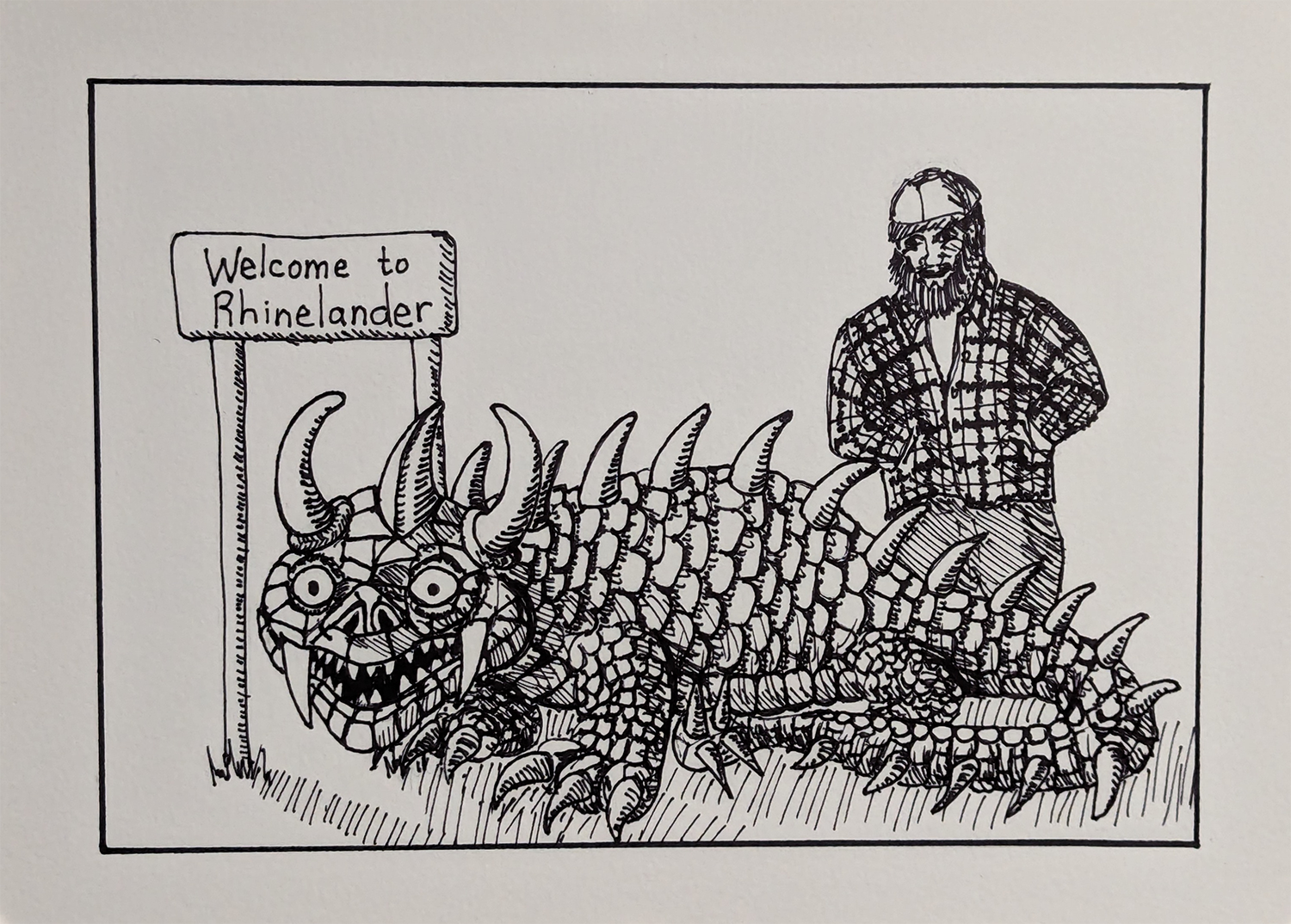I hesitated to even put this guy on the page. The Hodag is an example of every single thing serious cryptologists hate. This time they aren’t really wrong.
The Hodag is a proven hoax. It isn’t even based on any kind of animal that might exist. In short, it is basically a fictional town mascot. Not even lore, other than the legend of the humbug Eugene Shepard whose name should be mentioned alongside the great humbug PT Barnum.
At any rate, it was still fun to draw and the story is interesting enough to warrant conversation. So here it is:
The Hodag Story: A Narrative of What Actually Happened
In the late 19th century, Eugene Shepard, a land surveyor and well-known prankster from Rhinelander, Wisconsin, concocted a tale that would capture the imaginations of many: the story of the Hodag. In 1893, Shepard claimed to have discovered the creature, describing it as a fearsome beast with a frog-like head, massive horns, spiky back, and long tail. According to Shepard, the Hodag was the reincarnation of the abused oxen of Paul Bunyan, a legendary lumberjack.
Shepard’s initial claim included capturing and killing the beast, which he displayed at the first Oneida County Fair. The exhibit featured a realistic-looking Hodag made of wood and animal parts. Despite skepticism, the tale spread, and the Hodag became an emblem of local folklore.
The Legend and Lore
The Hodag legend quickly grew, fueled by Shepard’s elaborate stories and the mysterious nature of the Northwoods. The creature was said to dwell in the dense forests around Rhinelander, terrifying lumberjacks and townsfolk alike. Descriptions varied, but common attributes included glowing eyes, a pungent smell of buzzard meat and skunk perfume, and an insatiable appetite for white bulldogs, its favorite meal.
Despite the far-fetched nature of the tale, many were eager to believe, and the Hodag became a symbol of the region’s rich storytelling tradition. In 1896, Shepard upped the ante by claiming to have captured a live Hodag, which he exhibited in a dark tent, further thrilling (and deceiving) visitors with hidden wires and an unseen assistant manipulating the creature.
Eventually, Shepard admitted the hoax to the Milwaukee Sentinel, revealing the Hodag as a fabrication. Nonetheless, the legend persisted, embedding itself into the cultural fabric of Rhinelander and beyond.
Rhinelander’s Current Festivals
Embracing its mythical mascot, Rhinelander has transformed the Hodag legend into a source of community pride and celebration. The town hosts several events and festivals that celebrate the Hodag and the region’s unique heritage.
Hodag Country Festival
One of the most notable events is the Hodag Country Festival, an annual music festival that began in 1978. It draws thousands of country music fans to Rhinelander for a multi-day event featuring performances by top country artists, local bands, and emerging talent. The festival includes camping, food vendors, and various family-friendly activities, making it a significant cultural and economic event for the town.
Hodag Heritage Festival
Another popular event is the Hodag Heritage Festival, which celebrates Rhinelander’s history and the Hodag legend. The festival includes a parade, historical reenactments, arts and crafts, food stalls, and Hodag-themed merchandise. It provides an opportunity for locals and visitors to engage with the town’s folklore and enjoy community festivities.
Other Community Events
Throughout the year, Rhinelander embraces its mythical creature through various smaller events, school activities, and local promotions. The Hodag appears in mascots for sports teams, logos for businesses, and even as public art installations. The town also features the Hodag statue, a popular tourist attraction that symbolizes Rhinelander’s connection to its legendary creature.
Conclusion
The Hodag story, born from Eugene Shepard’s imagination and prankster spirit, has evolved into a beloved piece of folklore that continues to define and enrich the town of Rhinelander. From its origins as a hoax to its present-day celebration in festivals and community events, the Hodag remains a vibrant and enduring symbol of local culture and identity.


